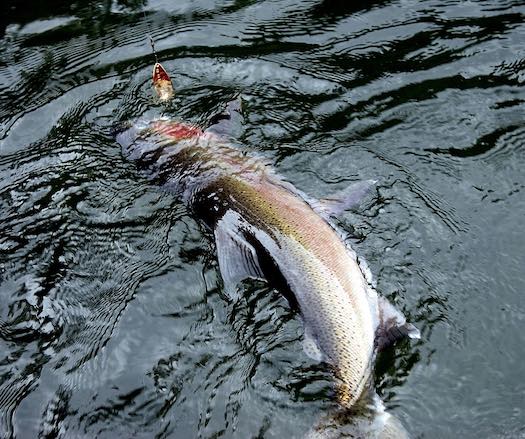forum
library
tutorial
contact

The Grim Outlook for Columbia
Basin Salmon and Steelhead
by Yancy Lind
Bend Bulletin, September 18, 2019
|
the film forum library tutorial contact |

|
The Grim Outlook for Columbia
by Yancy Lind
|
 Bonneville Dam is the lowest of many on the Columbia River. All salmon and steelhead moving upstream to rivers like the Deschutes, John Day, Grande Ronde and further into Washington and Idaho pass through Bonneville where they are counted. As of Sept. 11th, a total of 123,504 fall chinook and 60,867 (including 31,946 unclipped) summer steelhead have been counted. This may sound like a lot, but it is a fraction of their historical numbers.
Bonneville Dam is the lowest of many on the Columbia River. All salmon and steelhead moving upstream to rivers like the Deschutes, John Day, Grande Ronde and further into Washington and Idaho pass through Bonneville where they are counted. As of Sept. 11th, a total of 123,504 fall chinook and 60,867 (including 31,946 unclipped) summer steelhead have been counted. This may sound like a lot, but it is a fraction of their historical numbers.
We are now well past the half way point in the 2019-2020 return year for steelhead. Adult returns this year are well under last year's disastrous numbers over the same period and a small fraction of the 10 year average, which is also far lower than the average since counts began in 1938. Fall chinook returns are similarly depressed.
The United Nations reports that "humans are transforming Earth's natural landscapes so dramatically that as many as one million plant and animal species are now at risk of extinction." Columbia Basin salmon and steelhead are likely on this list, especially the upper basin runs.
This depressing situation is due to the "5 Hs":
It is also important to understand that many hydroelectric facilities have become economically obsolete. The Bonneville Power Administration is a quasi-governmental agency that operates dams on the Columbia River. Multiple news outlets have recently reported that the BPA is "going broke." The power the dams generate is now more costly to buy than wind and solar power. It is estimated the BPA has 10 years of viable operation left, about the same time that many experts give some runs of salmon and steelhead. Dams on the Klamath River are scheduled to be removed over the next few years due to their lack of economic viability.
I am one of the many anglers who loves to fish for steelhead on Oregon rivers, especially the Deschutes. But, how can we sport anglers justify continuing to target these fish? Even with best catch and release practices we kill some and reduce the odds of released fish successfully spawning. They only have so much energy stored up for the journey from the ocean to their spawning beds.
This tragedy impacts more than sport anglers, however. Anyone who enjoys eating locally caught salmon or is a lover of our natural environment should be deeply concerned.
There are ways you can help. If you are a steelhead angler, you can make choices to avoid impacting wild steelhead in the Columbia Basin for now. This includes the Deschutes River. Contact your U.S. senator and representative to express your concern, especially about the future of the BPA and urge that proactive steps be taken now to safeguard fish before the BPA becomes insolvent. Contact the conservation organizations you support and make sure they are treating the current situation like the crisis that it is. The National Wildlife Federation and The Conservation Angler are doing exactly that.
Related Pages:
With A-Run Steelhead Not Living Up to Predictions, Fish Managers Downgrade Forecast by Eric Barker, Lewiston Tribune, 8/31/19
learn more on topics covered in the film
see the video
read the script
learn the songs
discussion forum
